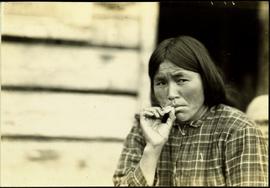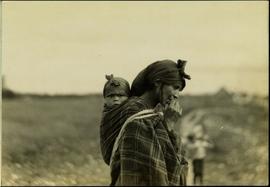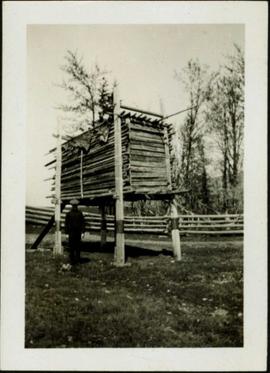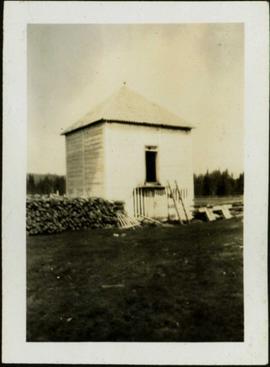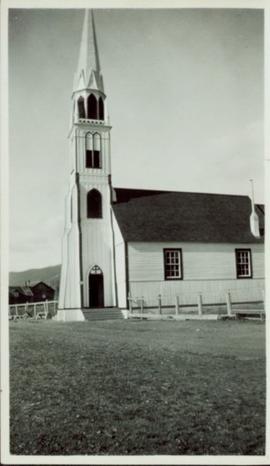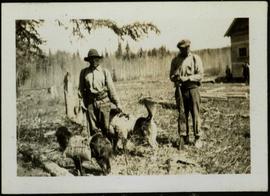Typed annotation on recto: "Indian Girl at Fort St. James Stuart Lake, B.C." Young woman smoking in front of unidentified building.
Fort St. James, BC
8 Archival description results for Fort St. James, BC
Typed annotation on recto: "Indian papoose at Fort St. James Stuart Lake, B.C." Child, wrapped in plaid blanket, being carried on back of woman in a field, other people in background.
Photograph depicts man standing in front of elevated, rectangular cache made of wood. Trees stand behind log fence in background. Handwritten photo caption below photograph reads: "Indian Cache." It is believed that this photograph may have been taken near Fort St. James, BC.
This file consists of copies of two manuscript items relating to the history of the Oblates in Northern British Columbia; the third item is a copy of the transcription and translation of one of these accounts. Includes:
- A copy of a type-written unpublished account possibly written c. 1922 entitled "Indian Schools of Fort St. James and Fraser Lake, B.C." The account is written by Father Elphage Allard, OMI on the founding of the residential school at Fort St. James and later of the building of the residential school at Lejac, near Fraser Lake, BC. Allard refers to his, and his younger siblings', also named Father Allard, involvement in the building of the residential schools at Fort St. James in 1916-1917 and subsequently at Fraser Lake ca. 1920-1922. Father Allard provides a detailed account of daily life and spiritual work conducted by the Oblates at the schools including daily routines of the First Nations students, dormitory life, educational curriculum, religious education, and arrival of a group of the Sisters of the Infant Jesus Congregation to assist at the school. The account provides descriptions of the 1918 flu epidemic and deaths that occurred among communities at Fort St. James, Pinchi, Tachi, Fraser Lake and Lake Porteur; involvement of the Anglo-Europeans in the construction of the schools; and interactions with the Chinese cook and Indian Agent in the communities. The manuscript also provides brief account of Allard's journey to provide religious services to other First Nations communities including Fort Graham, McLeod Lake, Atlin and Whitehorse. Both Father Allards were subsequently dismissed from involvement in the Fraser Lake School in 1922.
- A copy of a handwritten account by Father Jean-Marie Lejeune entitled "Comment la Sténographie a été introduite dez les sauvages" written by Lejeune at the Indian Missionary, Kamloops, B.C. c.1890-93 in which he describes his introduction of the shorthand in British Columbia to First Nations in the Kamloops region and the subsequent publication of the newsletter entitled Kamloops Wawa.
- A transcription and translation of Father Lejeune's account by William Poser with annotations.
Photograph depicts small square building with an elevated door, log pile on its left, and stand of trees in background. Handwritten photo caption below photograph reads: "Old Salmon cache. Fort St James, BC June 1923".
Exterior side view of a Catholic church built between 1876-1878 by Father George Blanchet. Handwritten annotation on verso in pencil reads: “Our Lady of Good Hope, Stuart Lake, Fort St. James, BC ”
Photograph depicts two First Nations men and two pack dogs loaded with bags. A small group of people can be seen in distance in front of semi-visible building. Stand of trees in background. Handwritten photo caption below photograph reads: "Indians & Pack Dogs - Fort St. James."
This file consists of photocopy reproductions of research material relating to the Missionary Oblates of Mary Immaculate (OMI) in Northern British Columbia, the Stuart Lake Mission, and the Our Lady of Good Hope Church in Fort St. James. Includes:
- Informational email from William O'Hara about the Our Lady of Good Hope Church in Fort St. James, 2014
- Reproduction of article by Bill O'Hara, "Our Lady of Good Hope Church first used at Christmas, 1878" from the Caledonia Courier, 17 Dec 1997
- Reproduction of "Missions de la congrégation des missionnaires oblats de Marie Immaculée - Dix-huitieme Année - No. 69. - Mars 1880" [French], a report that includes mention of "les Babines", "les Sékénés" [Sekani], "les Hotsoten" [Wet'suwet'en], Stuart Lake, Fort George, McLeod Lake, Babine Lake, among others
